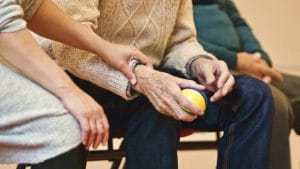20 Surprising Narcolepsy Statistics & Facts for 2024
written by / January 18, 2022
Imagine not ever being able to control your sleep-wake cycle. This is exactly the key problem of people with narcolepsy, a neurological disorder affecting wakefulness control.
According to the research and subsequent narcolepsy statistics and facts, the science behind these people’s sleep cycles is that their REM sleep and non-REM sleep blend into each other. Because REM is characterized by dreaming and a “paralysis” of the body—which keeps us from acting out our dreams and possibly getting injured—this overlap can become dangerous.
At DisturbMeNot, we’ve made an effort to elaborate further on this condition, highlighting its prevalence, risks, and symptoms.
The Top 10 Key Narcolepsy Stats & Facts
- Narcolepsy affects 3 million people worldwide.
- Type 1 narcolepsy has an overall prevalence of 25–50 people per 100,000.
- Narcolepsy can cause hallucinations.
- Only about 25% of people with narcolepsy receive therapy.
- Strong emotions in narcoleptic patients may induce paralysis.
- Some types of narcolepsy occur due to a loss of hypocretins.
- Scientists claim that narcolepsy is an autoimmune disorder.
- Taking Provigil, a commonly prescribed drug in narcolepsy treatment, may result in psychological and physical dependence.
- 68% of patients with narcolepsy claim that due to their diagnosis, they never feel like “normal” people.
- 84% of physicians feel that social media and modern entertainment contributes to a distorted perception of narcolepsy.
General Narcolepsy Facts
In this section, we’ll help you understand more about narcolepsy in general.
1. When a person has narcolepsy, this doesn’t mean they spend all their time asleep.
(Medium)
Contrary to a common misconception, individuals with narcolepsy don’t sleep constantly, though they do struggle with excessive sleepiness throughout the day. There’s also a heightened risk of patients falling asleep when they aren’t supposed to. In addition, though it may seem paradoxical, they may struggle with falling asleep at night.
2. There are two different types of narcolepsy.
(Verywell Health)
Here are some facts about narcolepsy with and without cataplexy. Type 1 narcolepsy is known to be accompanied by cataplexy, which refers to the sudden loss of muscle tone, typically due to a strong emotional response. Type 2, also known as narcolepsy without cataplexy, is marked by irrepressible daytime lapses into sleep, but without episodes of cataplexy.
3. The onset of narcolepsy usually occurs during childhood or young adulthood.
(Thomas Health)
The belief that narcolepsy doesn’t affect children is one of the widespread narcolepsy myths, and the facts, it seems, have proved it wrong. Although it can occur at any point in life, it usually affects young people between the ages of 15 and 25. However, it has definitely been seen in children under 15 as well, but it’s often either undiagnosed or misdiagnosed. Moreover, it’s usually initially interpreted as an emotional problem, attention deficit disorder, or even sleep apnea.
4. Another of the interesting narcolepsy facts notes that it can cause hallucinations.
(Sleep Foundation)
If you’ve ever woken up from sleep aware of everything around you but still unable to move, chances are you’ve experienced a condition called sleep paralysis. While the very possibility of being in such a state sounds scary enough, it can get even scarier and include hallucinations, which usually seem quite realistic. While this state can occur in anyone, it happens far more frequently in narcoleptic patients.
5. Excessive sleepiness isn’t fun, but the facts about narcolepsy suggest that it’s a highly manageable condition.
(Sleep Education)
The first thing that a physician will probably recommend to anyone with narcolepsy is changing their lifestyle toward a more disciplined one. Going to sleep and waking up at the same time every day, scheduling short naps during the day, exercising, and avoiding alcohol are all highly effective. Some physicians prescribe medications such as stimulants or SSRIs to alleviate cataplexy symptoms.
6. You probably know someone with narcolepsy without being aware of it.
(Sleep Foundation & Ranker)
Compared to many sleep-related conditions, narcolepsy has a lower prevalence, but statistics show that the condition affects 1 out of 2000 people. This is still relatively common, or at least common enough for most of us to get to know someone with narcolepsy. There are even some famous people with narcolepsy, like Jimmy Kimmel and Winston Churchill. Narcoleptic patients look just like anyone else on the outside—but they can struggle with the so-called “brain fog” while awake, making it hard to focus on daily tasks. Very often, those who aren’t informed of a patient’s condition have trouble understanding their behavior.
Interesting Medical Facts About Narcolepsy
Here, we’ll be exploring the medical side of narcolepsy, including side-effects of medications.
7. Strong emotions in narcoleptic patients may induce paralysis—probably one of the scariest facts about narcolepsy.
(Medscape)
Cataplexy is a common symptom occurring in people with narcolepsy. It consists of uncontrollable muscle weakness or paralysis that happens all of a sudden (mostly during the daytime). This is usually triggered by some strong emotion, either pleasant or unpleasant (excitement, laughter, annoyance, anger). During these episodes, a person loses muscle tone and experiences weakness in their body, often a slack jaw and broken speech.
8. Some types of narcolepsy occur due to a loss of hypocretins.
(Healthy Sleep)
Scientists studying narcolepsy offer important facts, having found that narcolepsy with cataplexy results from a deficiency of brain chemicals called hypocretins. This happens when hypocretin-producing neurons die off, which makes the REM phase of sleep in people with type 1 narcolepsy poorly regulated. This means that some of the elements of REM sleep manifest during wakefulness, such as paralysis or dreamlike phantasmagorias.
9. Scientists claim that narcolepsy is an autoimmune disorder.
(Medical News Today)
According to the fresh 2019 narcolepsy statistics, scientists from Denmark have found autoreactive cells in all of the analyzed blood samples of people with narcolepsy. These cells seem to “perceive” the body’s own hypocretin-producing neurons as “foreigners” set to invade them, as though they’re bacteria or viruses.
10. Taking Provigil, a commonly prescribed drug in narcolepsy treatment, may result in psychological and physical dependence.
(Medical News Today)
Provigil is relatively safe, and most people don’t face withdrawal symptoms after they’ve finished the therapy. Still, it sometimes happens, especially if the drug is used in high doses. Generally, it’s more likely to occur with people who have addictive habits and tendencies toward alcohol and drug abuse.
Narcolepsy Statistics Worldwide
In this section, we’ll be looking at statistics about narcolepsy from throughout the world.
11. Narcolepsy affects 3 million people worldwide.
(Narcolepsy Network)
Research suggests that narcolepsy affects 0.04% of people worldwide. Interestingly, this disorder is more prevalent in Japan, with roughly 1 out of 600 people suffering from narcolepsy. Meanwhile, data from the US reports that it affects 1 out of 2,000.
12. Only about 25% of narcoleptic people are diagnosed with narcolepsy, as statistics show.
(Narcolepsy Network)
This is probably the case due to frequent misdiagnosis since the symptoms of narcolepsy overlap with symptoms of other related disorders. A recent study has shown that up to 60% of patients get misdiagnosed, mostly with depression, insomnia, and sleep apnea.
13. People who have immediate relatives with narcolepsy are at a 20–40 times increased risk of developing it as well.
(Annual Reviews)
Researchers discovered mutations in the T-cell receptor gene in narcoleptic patients, which might be responsible for developing narcolepsy. However, when it comes to whether there’s a firm connection between narcolepsy and genetics, statistics show that most cases still occur in people without a family history of the disease.
14. Type 1 narcolepsy has an overall prevalence of 25–50 people per 100,000.
(UpToDate)
According to estimates, narcolepsy type 1 (narcolepsy with cataplexy) has an incidence rate of 0.74 per 100,000 people per year. Meanwhile, the prevalence of narcolepsy type 2 (narcolepsy without cataplexy) has been harder to verify. However, some research points to a prevalence of about 20–34 per 100,000 people.
15. In the case of narcolepsy with cataplexy, statistics following European populations show an estimated prevalence of 0.02%.
(Wiley Online Library)
Narcolepsy is a relatively rare disorder in both Europe and other parts of the world. The rationale behind such data is perhaps the frequency of misdiagnosis and general unawareness of the disease and its consequences. Hence, only a few European countries have registered narcolepsy cases in databases tracking rare disorders.
16. The statistics on people with narcolepsy state that about 30%–50% of them have had accidents due to suddenly falling asleep.
(Healthy Sleep)
Activities that might endanger people with narcolepsy range from the obviously risky ones such as driving and running dangerous machinery to cooking, or even just smoking. In order to prevent the dangers, people with narcolepsy need to understand the circumstances under which they usually become unfocused and fall asleep. Additionally, they might consider avoiding jobs that require prolonged focus under monotonous conditions.
17. Cataplexy affects roughly 75% of people with narcolepsy.
(Health of Children)
Statistics on narcolepsy show that a quarter of people with narcolepsy have experienced the previously mentioned dramatic episodes of cataplexy. This data confirms that more people suffer from type 1 narcolepsy. Cataplexy attacks are short (usually less than two minutes) and the person who experiences them always stays completely conscious.
18. In the UK, there are approximately 30,000 patients with narcolepsy.
(Narcolepsy UK)
According to the UK’s statistics about narcolepsy, it’s believed that there are 30,000 people with a confirmed narcolepsy diagnosis. However, as in other parts of the world, it’s highly likely that there are numerous undiagnosed or misdiagnosed cases.
19. 68% of patients with narcolepsy claim that due to their diagnosis, they never feel like “normal” people.
(Stat News)
Although this disorder is manageable, it can still affect an individual’s personal life and work performance. A survey showed that 45% of people struggling with narcolepsy state the disorder controls their lives. Moreover, 78% of the people surveyed agreed they had no idea what it would be like to live with narcolepsy prior to being affected by it.
20. Narcolepsy statistics show that 84% of physicians feel that social media and modern entertainment contributes to a distorted perception of narcolepsy.
(Stat News)
Recently surveyed US physicians report that many narcolepsy symptoms are usually ascribed to other conditions with similar symptoms, like depression or insomnia. Examinees living with the disorder report that they didn’t get diagnosed until approximately six years after their first symptoms showed. They all agreed that the media’s portrayal of narcolepsy is one of the greatest contributors to general unawareness and disinterest regarding this serious disorder. As a result, many are also unaware of the available treatment options, according to narcolepsy statistics in the US.
Conclusion
While narcolepsy itself isn’t a life-threatening condition, it significantly decreases one’s quality of life, potentially exposing an individual to possibly fatal conditions. Most people with this disorder aren’t even aware they have it, and the symptoms are often overlooked. As a result, someone with narcolepsy may struggle with their everyday routine for over a decade before getting an accurate diagnosis. This is why it’s crucial to raise awareness and stay informed. Hopefully, our narcolepsy statistics for 2022 have made a considerable contribution.










